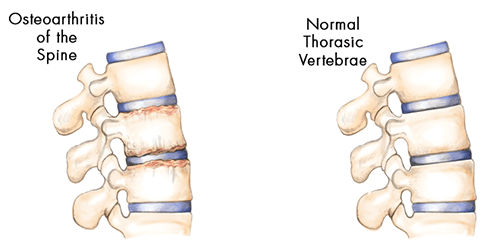Spondylosis Causes
Spondylosis is a commonly used term to refer to the degeneration of the spine as we age. Spondylosis involves the discs and vertebrae of the spine. Spondylosis can occur along the lumbar, thoracic, and cervical spine.
Spondylosis is a widespread spinal condition and worsens with age. More than 85 percent of those suffering from spondylosis are over the age of 60.

Spondylosis Risk Factors
As with many other degenerative spine conditions, spondylosis is susceptible to certain risk factors that increase the possibilities of someone developing the condition. Some of the risk factors associated with spondylosis include:
- Age: Since spondylosis is the response of wear and tear, age is a significant factor in its occurrence.
- Work: Jobs involving repetitive motions or awkward positioning of the spine place additional stress on the spine.
- Sudden injuries: Previous or unexpected injuries to the spine can increase the risk of spondylosis.
- Genetics: In some cases, certain individuals may be genetically predisposed to excessive disc wear and tear or joint damage.
Common Spondylosis Causes
Unfortunately, the number one reason for spondylosis is age. With age, the protective cartilage and bones in the spine become prone to wear and tear that can lead to spondylosis. The most common causes for spondylosis include:
- Dehydrated discs: When the cushioning discs of the spine begin to dehydrate, they start shrinking, which procures more bone-on-bone contact between the vertebrae, exacerbating wear and tear.
- Stiff ligaments: The tissue that connects the bones is known as ligaments. When spinal ligaments become stiff, the spine becomes less flexible, accelerating its degeneration.
- Abnormal movements: Hypermobility or abnormal spinal movements can lead to bone spurs, degenerative discs, and other spine conditions that can lead to spondylosis.
Conditions that Cause Spondylosis
As the spine begins changing with age, it becomes more prone to certain spinal conditions that can lead to spondylosis or a degenerated spine. Most degenerative spine conditions can lead to spondylosis. Some of these conditions include:
- Herniated discs: A herniated disc can press on the nerve roots and spinal cord inflicting moderate to acute pain.
- Bone spurs: Spine degeneration often results in extra bones produced by the spine, also known as bone spurs, which can in some cases pinch the nerve roots.
- Spinal stenosis: Spinal stenosis occurs when the spinal column canal narrows, which leads to compression of the spinal nerves and cord.
- Spondylolisthesis: This condition occurs when a vertebrae clips backward or forward in the spinal co;lumn losing its original place.
- Facet Syndrome: This is a degenerative condition that occurs when cartilage within the facet joints wear down.
